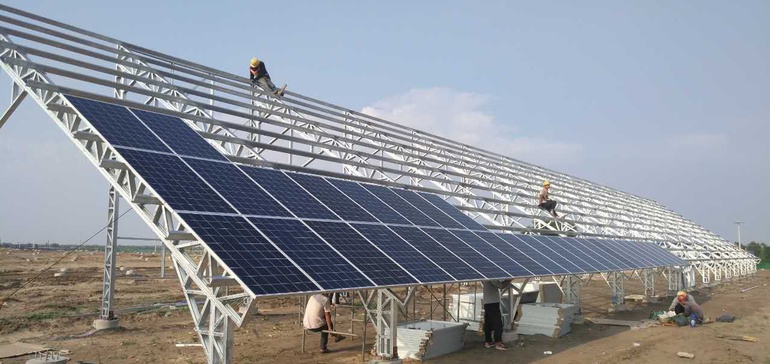
Dive Brief:
- The installed cost of solar photovoltaic (PV) and battery storage systems continued to drop between 2020 and 2021 in the U.S., with utility-scale solar systems seeing a 12.3% price decline, according to a new report from the National Renewable Energy Laboratory (NREL).
- The cost of residential PV fell 3.3% and commercial rooftop PV systems dropped 10.7%, the report found. The calculations rely on a bottom-up model that accounts for all costs during installation, including hardware, sales prices and labor.
- The report found that balance of system costs – encompassing everything except the PV panel – had either increased or remained flat, but an overall 19% reduction in module cost drove the cost declines. A separate NREL report examined various types of PV technology and found potential cost savings for each.
Dive Insight:
To meet the Biden administration’s ambitious goal to achieve a net zero power sector by 2035, experts agree the cost of solar power and energy storage will need to drop. NREL reports that solar and storage costs have both fallen over the past decade. The price of residential solar, for example, was reported at $2.65/W in the first quarter of 2021, down from $7.53/W in 2010; utility-scale solar was $0.89/W compared to $5.66/W a decade ago.
That was driven in large part by higher module efficiency and lower module cost, NREL researchers said in a webinar on Tuesday. A separate report found that the price of different module technologies – including crystalline-silicone, cadmium telluride and copper indium gallium diselenide – are forecast to drop in the coming years with more efficient manufacturing.
Amid concerns of a supply chain crunch for raw materials, the NREL report mostly found its impact in residential solar installations, hence the lower cost decrease. However, David Feldman, a senior financial analyst for NREL, said in the Tuesday webinar that the solar and storage cost report covered the first part of the year and that supply chain constraints, as well as any trade tension with China, could impact the findings of next year’s cost benchmark.
NREL also found that energy storage technology – a key component of a decarbonized grid to store and dispatch energy at times of high demand – is getting cheaper. The price of residential standalone battery storage (modeled at a 5kW/12.5kWh system) fell nearly 10% between 2020 and 2021. Commercial standalone storage (modeled for 600 kW/24 kWh of usable energy) fell 10.7% and sits at $481/kWh, while utility standalone storage (60 MW/240 Mwh of usable energy) fell to $379/kWh, a 13% drop. Similarly, the prices of paired solar-plus-storage projects fell significantly.
The passage of an investment tax credit for standalone storage projects included in Democrats’ budget reconciliation package could drop installation costs even further, industry analysts say, although that was not reflected in the NREL report.
That finding reflects the results of several other reports that have also found significant decreases in the price of energy storage. BloombergNEF’s (BNEF) annual battery price survey released this week found that volume-weighted lithium-ion battery pack prices fell 6% on average globally between 2020 and 2021 and a whopping 89% in real terms from 2010 to 2021. That drop applies to batteries used for electric vehicles, buses and energy storage, with a pack price of $132/kWh in 2021.
However, the BNEF report also found that raw material prices could cause a slight increase in the pack price in 2022, potentially pushing back the date when prices fall below the benchmark level of $100/kWh and upsetting long-range plans for storage projects and automakers seeking to make electric vehicles more affordable.
“This creates a tough environment for automakers, particularly those in Europe, which have to increase EV sales in order to meet average fleet emissions standards,” James Frith, BNEF’s head of energy storage research, said in a statement. “These automakers may now have to make a choice between reducing their margins or passing costs on, at the risk of putting consumers off purchasing an EV.”






